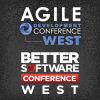Agile Development Conference & Better Software Conference West 2011

PRESENTATIONS
|
Practices, Principles, and Values: Moving Beyond Dogma to What Works
The concept of software process improvement is not new. Many methods have been defined to conduct and pursue improvement. We never seem to lack for “improvement” ideas, as if they are fresh and exciting-which they often are not. Maybe that's because so much of what has been espoused through the years has not worked. Hillel Glazer examines long-held assumptions about process improvement, proposes plausible flaws, and reveals new levels of understanding that have facilitated breakthroughs in high performance. |
|
|
Prefactoring: Extreme Abstraction, Extreme Separation, and Extreme Readability
Developers often run into the same issues on every project. As the software is created, design problems start to creep in-causing maintenance releases with no new features, project delays, and worse. While some of these problems can be resolved by simple refactoring, others can be fixed only by a complex code restructuring effort. |

Ken Pugh, Net Objectives |
|
Product Owner Anti-Patterns
Do you want a successful product delivery-one that has cost-effective and prioritized product features, that has support from the organization, and acceptance from key stakeholders? If so, you need an effective and available product owner (PO) on your Scrum projects. While good POs work with the team to foster high productivity and quality, a bad PO can destroy the project. Bad POs manifest ineffective or counter-productive practices known as anti-patterns. |
|
|
Quality Requirements: Succeeding with Waterfall Releases
While there is much excitement surrounding agile, many complex or outsourced projects do not fare well under agile. In these situations, requirements and architectural design cannot emerge with the software; they need to be defined and documented before coding starts. Filip Szymanski explores important practices in waterfall projects to help ensure requirements quality while speeding up development. First, Filip explains how to speed up waterfall releases by fully engaging QA/test teams in the requirements process. |
|
|
Questioning Best Practices: The Story of One Test Team's Transformation
John McConda presents the story of a test team that challenged the notion of best practices and came out more focused, efficient, and effective. Creating a mission statement and using it as a measuring stick, this team threw out all practices, started with a clean slate, and scrutinized every proposed process and practice. They sought to understand and evaluate each practice-based contribution to the testing mission. |

John McConda, Moser Consulting |
|
Reading the Tea Leaves: Predicting a Project's Future
What clues from a project's history and present status give us the best insight into its future? Realistically, can much be done to "fix" a project if the current signs aren't promising? Or are most projects' fate preordained? Payson Hall has participated in and reviewed hundreds of projects during his thirty-year career in software development. Without claiming mystical powers, Payson shares patterns of failing projects he's observed on large and small software projects in both the public and private sectors. |

Payson Hall, Catalysis Group Inc |
|
Risk-based Development with Standards-compliant Software
When challenged with designing and developing standards-compliant software using a risk-based approach, it is essential to understand regulatory law, industry best practices, and the consensus standards recognized by regulatory bodies (FDA, ISO, and the EU). Thomas Bento helps you sort through the challenges of regulatory expectations to move confidently and defensibly forward with risk-based development using consensus standards, including IEC 62304 and ISO 14971. |
|
|
Sleep Better at Night: A Release Confidence Metric
A project manager decides a product is good enough to release-that it will be successful in the marketplace or the business. The manager is basing this judgment on confidence in the product. Confidence is a simple word, yet it is an extraordinarily intangible measure. Confidence drives a huge number of software releases each day. Can our confidence be quantified? Can it be measured? |

Terry Morrish, Synacor |
|
Software Design in the 21st Century
Over the past decade or so we've seen important new ideas added to the mix of software design practices to help us produce better software. Design Patterns help us capture the design solutions and reveal a rationale for using them. Refactoring allows us to improve system design after the code is written. |
|
|
Specifying Effective Non-functional Requirements
Non-functional requirements present unique challenges for authors, reviewers, and testers. They often begin as vague concepts such as "The software must be easy to install" or "The software must be intuitive and respond quickly." As written, these requirements are not testable because they are subjective. Definitions of "easy", "intuitive" and "quickly" are open to interpretation and dependent on the experiences of the reader. In order to be testable, non-functional requirements must be quantifiable and measurable. |

John Terzakis, Intel Massachusetts |


